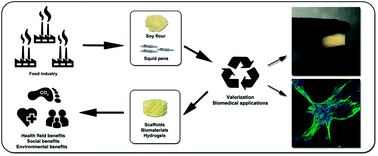Soy protein and chitin sponge-like scaffolds: from natural by-products to cell delivery systems for biomedical applications†
Abstract
The increasing necessity of developing new devices for biomedical applications has added a growing social need of being environmentally respectful. In this work, we have shown that natural by-products from the food industry (soy protein and β-chitin) can be an excellent source of biomaterials to produce 3D scaffolds through simpler and cleaner processes. With the mixture of these two polymers, we have developed sponge-like scaffolds (SLS) with great physicochemical properties. Furthermore, a dialysis pre-conditioning step was enough to obtain negligible cytotoxicity in vitro. The predominant M2 macrophage profile, an elevated deposition of collagen fibres and the enhanced neovascularization capacity suggested excellent biocompatibility also in vivo. Moreover, these SLS were able to promote cell adhesion, proliferation and high loading capacity. Finally, h-MSCs 3D-cultured in these SLS released four times higher VEGF than h-MSCs seeded onto 2D plates. The green thinking strategy, properties and biocompatibility of this SLS highlight its potential as a cell delivery system for biomedical applications.



 Please wait while we load your content...
Please wait while we load your content...